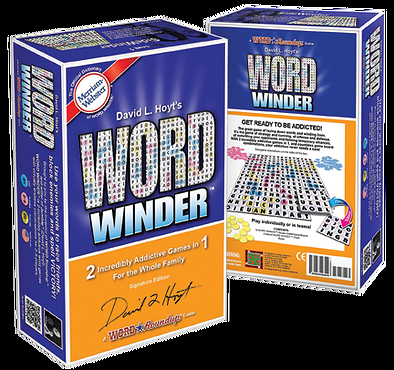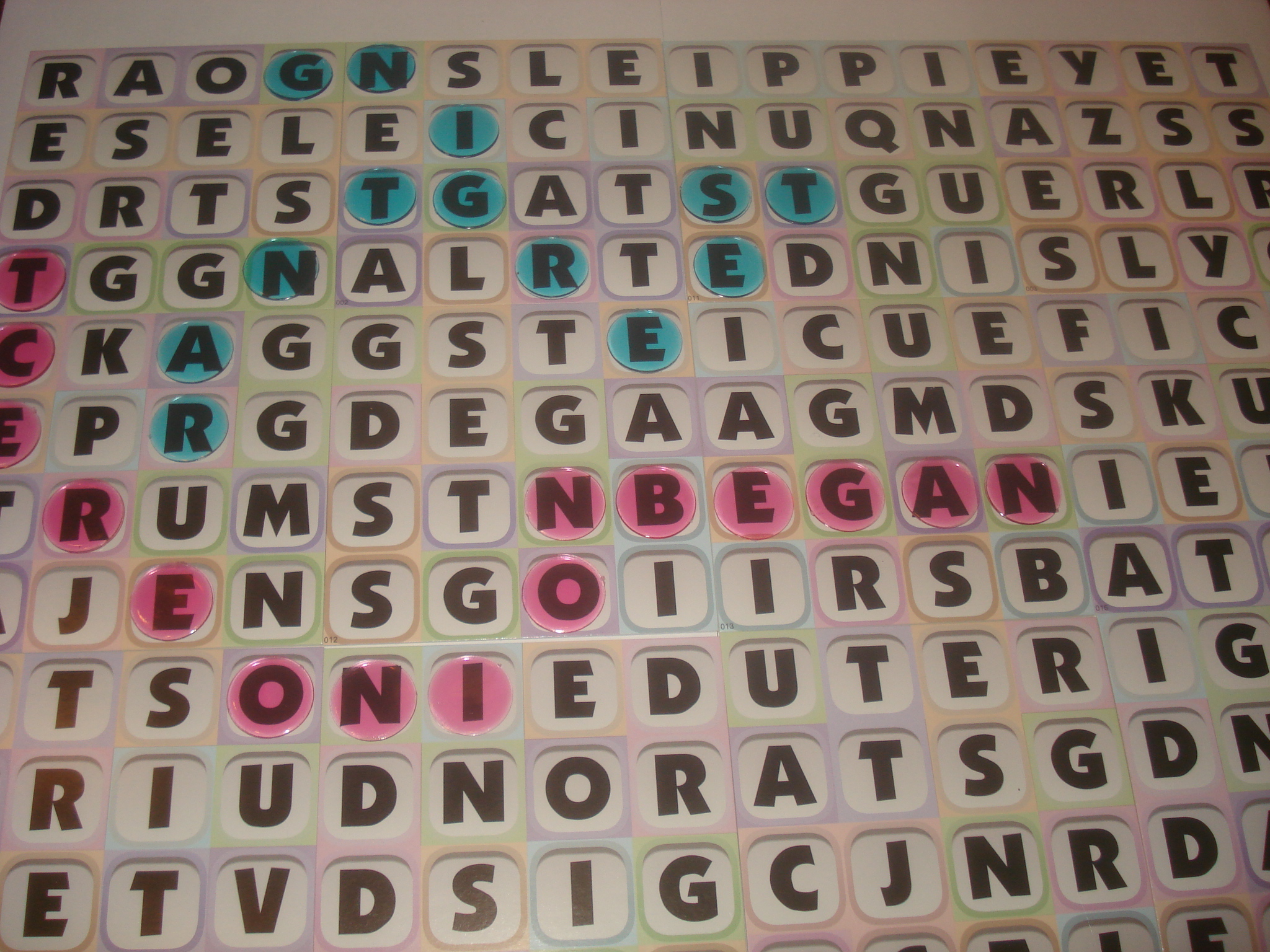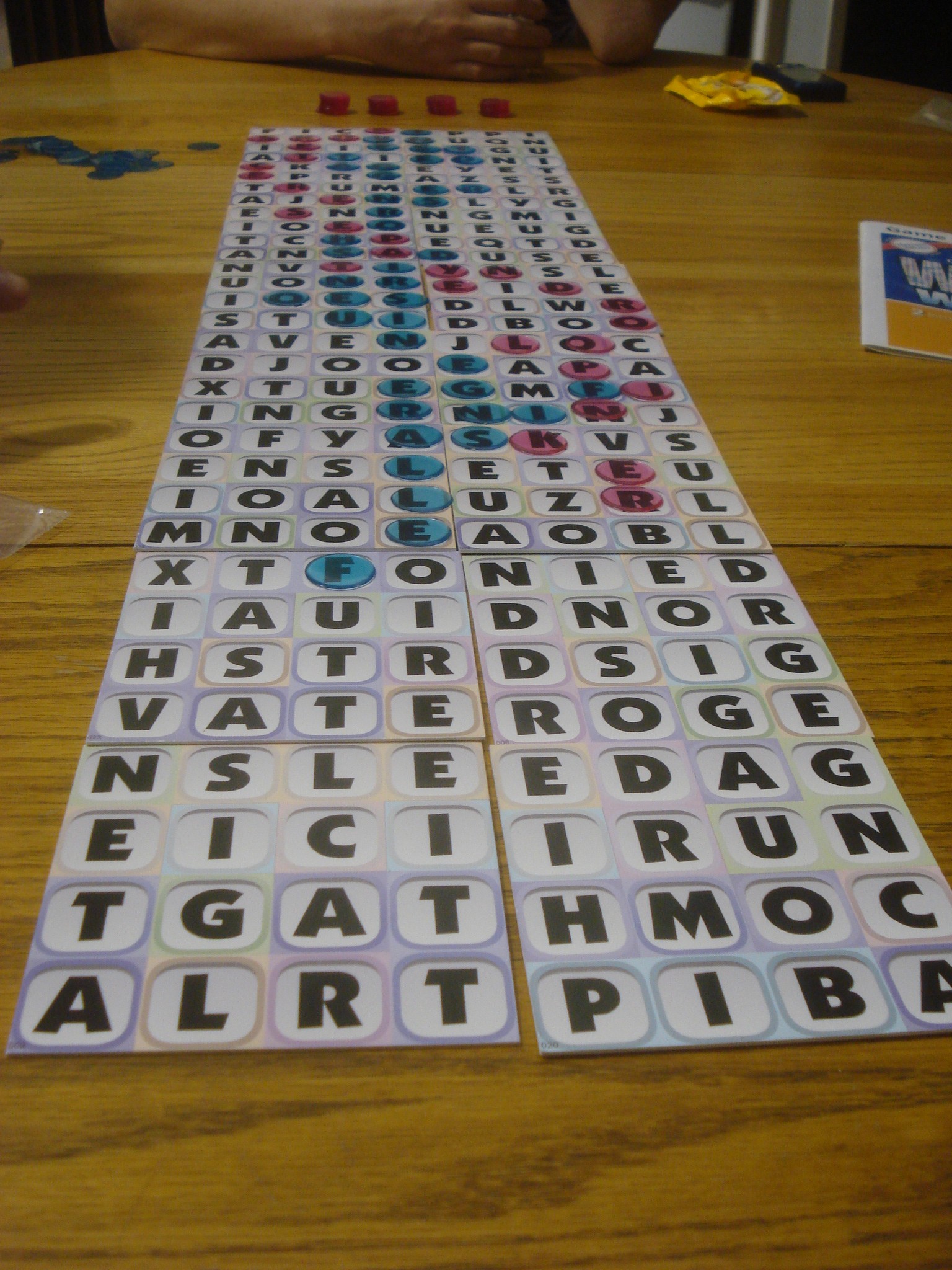| Publisher | Word Winder Inc. |
| Design Credits | David L. Hoyt, Graeme Thompson, and Steve Bullock |
| Game Contents | 16 double-sided board tiles, three sets of 70 colored tokens, three plastic token cups, rules |
| Guidelines | Multi-word-connecting board game |
| MSRP | $19.95 |
| Reviewer | Andy Vetromile |
Games about words seem to prevail these days, especially on the Internet where entire court cases about them are keeping whole teams of lawyers busy. If you’re looking for something a bit more intimate, with old-fashioned face-to-face confrontations over what constitutes slang, then perhaps you’re looking for something like Word Winder. Are you? Read on.
The object of the game is to be the first person to cross the board with a line of words.
The game comes with several tiles, full of letters in a four-by-four grid, back and front. Set beside one another, the tiles form a play area ripe with possibilities. On his turn a player places his colored tokens on the letters he wants to use. Words can be traced from one letter to the next, diagonally or orthogonally, according to the rules employed in most word games (no slang, no proper nouns, and so on). Anyone who’s ever played Boggle is familiar with this procedure, but Word Winder plays out on a larger surface. Then the next player makes a word.
If a player makes a solid, orthogonal line out of his words, an opponent cannot cross it; if there are crooked spaces where a player went diagonal, though, then someone can slip through that “crack” by also playing something on a diagonal. A player can’t use the same printed letter twice in one word, but he can state he’s reusing letters he covered with his tokens on one of his previous turns (he can’t swing back to the same R to spell R-O-T-O-R but he could use some of those same letters next turn to produce O-R-A-T-E).
There are two ways to play, SideWinder and RaceWinder. In SideWinder the tiles are laid out in a four-by-four square arrangement, and the winner is the first player to form an unbroken line of words top to bottom or left to right. Players may create words wherever they please, to advance their own position or to block an opponent. In RaceWinder the tiles snake downward, one row per player like lanes on a runner’s track, and the object is to be the first player to get from the top of the board to the bottom in an unbroken line. Players must start with one of the topmost letters, and play each successive word adjacent to, or using, letters from one of their previous words – they cannot play just anywhere as in SideWinder. This means if you’re hemmed in, your game is over (in SideWinder you just start another line elsewhere). They can still play in any direction, though, so words could start in the middle of the board and stretch backward to touch a previous play.
There’s a lot to like in the box where the letters are concerned. Most of the pitfalls for word games are taken care of here – the Qs are always next to a U, for example, and usually more than one. The creators have seen to it there’s a plethora of -est, -er, -ing, re-, un-, and so on. Graphically, the letters are shaded with light pastels, an obvious but not distracting separation. The plastic playing chips aren’t as impressive, and in fact are a bit disappointing. The good news is they’re translucent, and pretty stable once they’re laid on the tiles; the bad news is everywhere else they’re slippery as eels. Just picking them up out of the token cups two at a time risks one of them popping out of your fingers to land who-knows-where. Further, the edges belie a poor molding – little plastic flanges hang off a few them, some sharply so. A spot of work with a file or knife may be needed before play. (The company thoughtfully provides a couple extra of each color, though something other than the yellow would have been easier to spot.) The cardboard insert is almost a useful item, with holes for the token-filled cups, but those slick chits are going to spill throughout the box in transit regardless. Bring some small resealable bags. It has space enough for the tiles (and maybe a few more from upcoming supplements . . .?), with room for the pudgiest fingers to pull components out, though the board pieces also tend to shift.
In spite of Word Winder’s simplicity there are a few stumbling blocks in the rules. It doesn’t say whether you can cross your own line to make a word (say, in an hourglass shape), though since the copious rules examples don’t show it being done that hints at a “no.” On the other hand, one example doesn’t match its diagram – an arrangement of letters is shown as both diagonal and orthogonal in the discussion of “crossing” an opponent’s lines. Although listed for “2 – 6″ players, playing with three is done singly while four or six requires team play. This isn’t onerous, since it brings up other strategies that must be considered (and are fun to toy with . . . do you want teammates to confer or no?), but it does technically leave out five players, a popular number in light of the rise of Eurogames. Of course, you can always have two teams of four and one player running solo, especially if you want to handicap the word-game whiz of the group. They also have suggestions for handicapping when kids are involved.
Word Winder is a fun if somewhat simple game. Again, it seems to borrow from Boggle but gives the mechanics a more competitive, interactive goal that livens play. That vigor sometimes gets lost in analysis paralysis, an ever-present problem when looking for the perfect word length, width, or placement (the booklet suggests a timer), but it does elevates one’s game and at that point it’s a pleasantly concise pastime. Those looking for the standard vocabulary challenge may wish to remain firmly in the Scrabble camp, but anyone who seeks a slightly wicked edge on their contests may prefer the intelligent interference of Word Winder.


